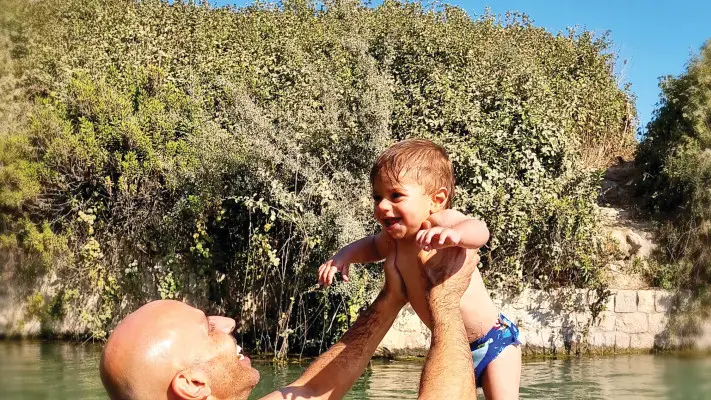Thanks to the Romans
Ein Yavka // Alon French
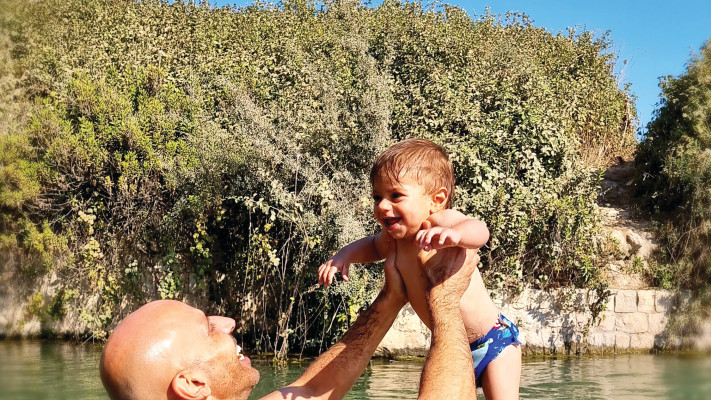
Dad, I'm hot. Dad, I'm cold; Dad, I have sand in my shoe. Dad, I have water in my shoe; I have poop. I'm starving; When do you arrive? When are you coming back? The task of taking my arrogant and middle-class Tel Aviv kids out into nature is always met with difficulties and bumps, which make me want to do a U-turn, go home and order from Walt. Nature is an enemy and must be treated as such – with this mantra, it is difficult to get far. All the desire leaves even before reaching the Cinema City Gillot intersection (they know this N.C., by the way, very well).
This is where our ancestors walked: trips to the places where the Israelites passed during the exodus from Egypt
Amsterdam is banning the construction of new hotels as a way to combat over-tourism
And I don't blame them – I mainly blame myself. Wait, why blame myself if I can blame my parents? It turns out that my childhood memories also do not include climbing Masada (only in Bnei Akiva) or traveling across Israel (even in a car it seems like a tedious task to me).
The only nature we saw was on the annual vacation in August, in a large tent that fits seven people on the shores of the Sea of Galilee. The only march was a penguin walk on the pebbles of the Sea of Galilee, from the tent to Lima.
And here, there is also a happy ending: We Did It! We were in nature, and we even had a great time. We had so much fun, that the children ask "when again?" In order to succeed in the task, it is necessary to have a refuge: we informed the children that they were going to a hotel in the north (these were calm days, of course), with two pools (it's really magic for them) and two meals a day (it's really magic for us).
On the way, we said in advance, we stop at a spring, to wade in the water. Somehow, the word "water" confused them. Maybe they imagined a water park, maybe they didn't understand what the word "spring" means, maybe I whispered the news. No voices of protest were heard in the car. We breathed a sigh of relief.
We arrived at Ein Yavka, and its Hebrew name is Ma'ayan of the Horses. The water from the spring in the Lower Galilee fills a rectangular pool about 25 meters long and one meter deep, and it even has steps that make it easier to get in and out.
All this thanks to the Romans who ruled the country and established for themselves the closest thing to a water park. The feverish sun above, in front of the cold water below, make bathing a thrill. The water is clear (don't get excited when you hear "Daddy, there's an animal here". Yes, my child, it's a dragonfly), the traffic is moderate and allows for family intimacy and no less important – there is no real cellular reception, so the children cannot "escape" to the phone. This, in itself, already entitles the Romans to the prize of Israel.
We had so much fun, that on the way back from the hotel, when we are exhausted and just waiting to get home, lie on the couch, watch Netflix and order Walt, the kids asked "let's stop at the spring". With all due respect to nature, we too have a limit.
As a beach should be
Geash Beach // Dror Raphael
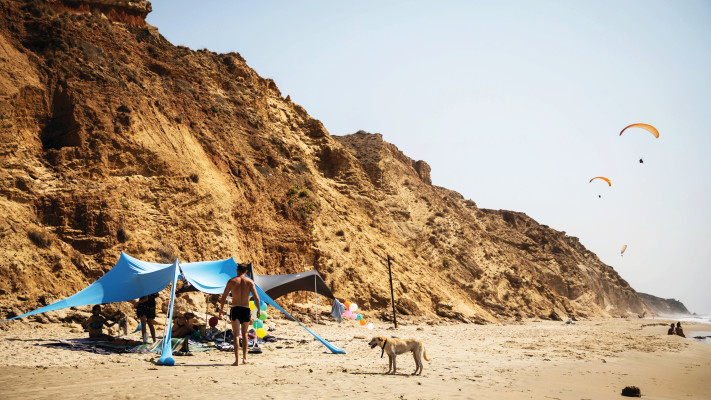
It's not enough that I refuse to travel, the song "get up and walk in the country" also makes me feel bad, because it is imperative. No one of his own free will wakes up on Shabbat and starts walking around with a backpack and a cane. Let us sit at home and watch Netflix. The itineraries are similar or it seems that we have already been to all of them on an annual trip. Canada forest. Sahana The snake trail. we did we saw We didn't enjoy it.
A little track, a little stream, half a cave, and we have lunch outside. With flies, a rocking chair, and remembering that we forgot something small and important like an opener, salt or a tent peg. God forbid. Tent. There is no harsher drowsy punishment than sleeping under the open sky. The only ones who enjoy it are 17-year-old kids who play guitar and get excited about a sunrise.
Still, there is a place that manages to amaze me every time, and it's almost a miracle that a building complex with a shopping center has not yet been built there. And it is a volcanic beach. The descent itself is between two cliffs as the coastline slowly opens up like on the Italian beaches of San Remo.
As you progress, you disconnect from everything, also literally – because there is no reception there, and descend to a pleasant, almost pristine beach, as a beach should be. Open, liberal and quiet. No whistles, annoying ticking noise or a lifeguard screeching through the speakers. If you dream along the beach, you will discover separate beaches, gays beach, nudist beach and recluse beach. It is hard to believe that in the center of a country that is becoming more and more conservative and religious there is a place that no Smotrich or Gafni have yet threatened to close.
Eternal wonder
Ramon Crater // Yossi Achimair
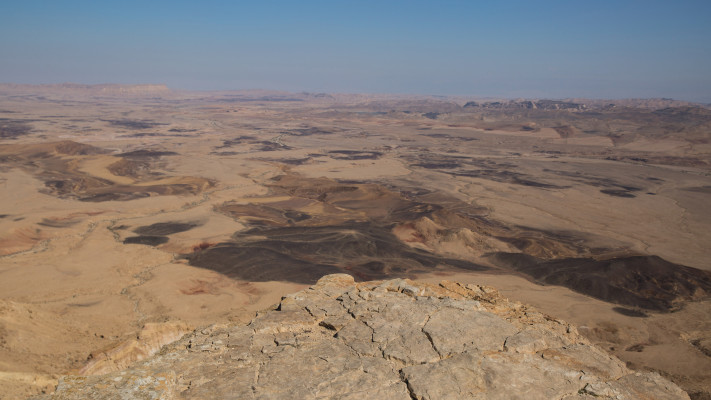
Take a breath, reach out your hands to the sides, look forward, to the right and to the left, at the primordial sight that will be revealed to your eyes. You are standing on the cliff, near the visitor center, when the Ramon Crater is visible as if in the palm of your hand below you, in all its glory and power.
One of the most powerful natural wonders not only in our small country, but in the entire world. The beauty of creation, the strength of the desert, the smallness of man are appropriate to the appearance of the primordial landscape before and below us. Looking and not letting go. like hovering
Standing on the edge of the cliff of Ramon Crater. Caution! A trip could end in disaster. A tailwind may push you forward. And Kadima means – a drop of dozens of meters, H.V. A thin, fast-moving snake emerges from one of the cracks, moves quickly and disappears into a rock crevice. Fears man more than the abyss on a caterpillar bed.
A regulated path runs along the northern cliff and leads to a huge camel-like rock. From every point on the regulated road to it there is a spectacular view. The angles change, the heart is thrilled. Deer will look in bewilderment at those walking on two, and if they are not disturbed, they will continue to lick the bit of grass.
Especially for geology enthusiasts – and I am one of them, even though 55 years have passed since my incomplete studies – this is an exciting celebration. The ancient, beautiful rock types are displayed on a track railing with samples and explanations, accompanied by applications attached to the signs.
From the top of the "camel" you can see the settlement of Mitzpe Ramon on one side, the view of the crater on the other. Genesis is hundreds of millions of years old. Superficial explanation: an arch of rocks that rose ever since, the "soft" inside was swept away, emptied, and the arch fell, becoming a mighty bowl, on the edge of which we move, marveling at a view that has no equal in the world. Who are you, the person whose "days pass like a shadow", in front of this eternal wonder of nature.
Why are we here?
Hinnom's shoulder // Carmit Sapir Wietz
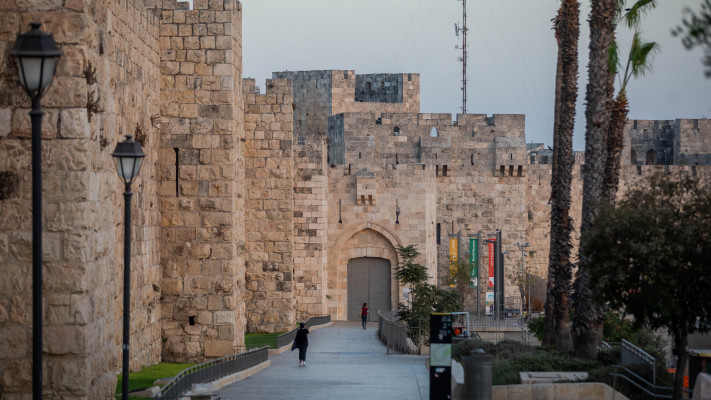
In the heart of Jerusalem, 755 meters above sea level, in front of the walls of the Old City, the Mount of Olives and the Judean Desert, a short distance from the Aut Mozar House, the Jerusalem Cinematheque and the Scottish Church, stands the hill that reminds us why we are here. You can get to Givat Tanach in two ways: one, by a winding path from the direction of the Khan Theater, near the Ra'anon station (a bag) left as a souvenir by British High Commissioner Sir Arthur Walkup.
The path leads to a green area strewn with blossoms that change according to the seasons: sedums and autumns, anemones, sabion and sedum. You should visit it, and pray very hard that the plan to build another hotel on it will disappear. The second road is level and regulated, between the Scottish Church and the Begin Heritage Center, accompanied by explanatory signs.
In archaeological excavations conducted by Gabriel Barkai, who gave the hill the name "Hinnom's shoulder", some of the most important findings in the city's archeology were discovered: a burial cave with over a thousand items, including pottery and glass, bone and ivory, some of which are rare luxury items that testify to the status of the buried.
The objects date to the end of the First Temple period (seventh century and the beginning of the sixth century BCE), the period of Babylonian rule during the days of the return of Zion (sixth and fifth centuries BCE) and the Second Temple period. Especially moving is the blessing of the priests made of pure silver in tiny scrolls worn on the body as amulets with the texts of the biblical blessing of the priests from a book in the desert, which indicate that it was common in the days of the First Temple in the seventh century BC. At the end of the visit, you can have a snack and coffee or a meal at the first station complex, which is a few meters away from the site.
A neighborhood legend
Kerem Hatiman, Tel Aviv // Dodi Fatimer
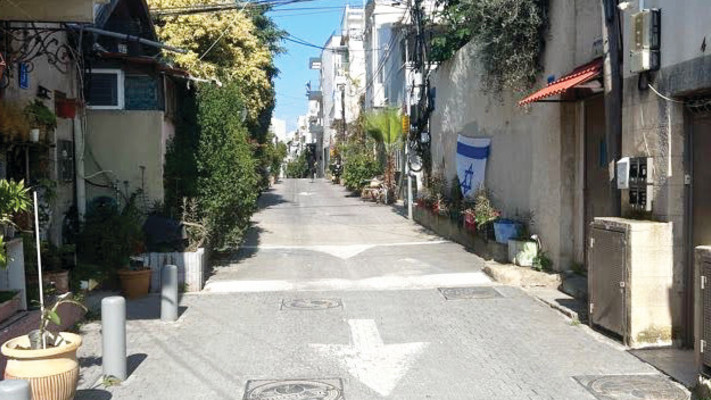
"There's a tiny neighborhood, it's in the heart of a big city/People like to eat delicious food/There's a tiny neighborhood, it's in the heart of a big city/Its streets are narrow – this is the Yemeni Vineyard" – so sang Ahuva Ozeri, from the legends of the Yemeni Vineyard, on the record "Forward with Pride" in 1978 And expressed well the feeling that surrounds everyone who comes for the first time, as well as for the umpteenth time – to the vineyard.
The first time I visited the vineyard was as a child. A family trip through the narrow streets and a child's wonder how such old buildings did not fall apart. In my adulthood, the question remained the same, but an answer was added to it: the Yemeni vineyard is one of the oldest, symbolic, beautiful and important pearls in Tel Aviv, which carries a history of 118 years and gives you an atmosphere that time has stood still: the restoration that threw in the old buildings only made them better.
The locals walk in simple clothes and smile widely; The noise of the cars does not exist and the noise and intensity of the city does not enter the neighborhood; From one street to another you can enjoy the magical aromas of the concept restaurants, from frying falafel and skewers, through the strong smell of Yemeni soup to the aroma of hummus Paul; And the tour guides and the curious tourists who pass from street to street steal more information for any passerby who happens to be there.
I can't describe the number of times I wandered (and still do) in the vineyard, a lot of it due to my occupation of documenting music, since many of the old musicians and the stories of the history of the Hebrew singer in general and the Mediterranean in particular – are connected to the vineyard: I met here for the first time my beloved Ozari who told me the stories of her life .
In the street next to it, I met Moshe Ben Mosh, the legendary guitarist who founded "Sounds of the Vineyard" with Declon in this very neighborhood 52 years ago; Ben Mosh also took me to meet his mentor, the late singer Moshe Mashomer, who in the 1950s founded "Tzlili Shabazi" on whose lap Daklon grew, he, Rami Danoch and Yehuda Kiser (members of "Tzlili Ha'Oud").
On another occasion I met Hofani Cohen and Baz Sharabi here, also Bnei HaKram, they and other artists told me about other days when people walked around the neighborhood for pleasure and sang their hearts out to make people happy, they didn't think about time and the daily work race and above all they chose simplicity.
When we, the director Ofer Panhasov and myself, filmed the documentary about her lover Ozeri Bakram, I was also exposed in depth to the mafia stories of the "Karam gang" of Tovia Oshri and Rahim Aharoni ("Rachami la Yade"), the first organized crime gang in Israel, an element that intrigued me even more Regarding a tumultuous time, and seeing the buildings, houses and areas where all the "smelly" businesses were conducted only added pepper to the history of the neighborhood.
The Yemeni vineyard is a place that to this day, when I visit it, I leave with more information, another friend or acquaintance that I didn't know before, more cultural sounds from the city's soundtrack and above all I feel that for an hour or more I managed to do the unbelievable and go back through the time tunnel to the 1950s. Who said you can't turn back the hands of time?
Israeliness in full force
Netavg // Shai Lahav
My favorite place in Israel is the National Bank of Israel. And I do not state this as a provocation, but as a marking of the point that most activates me emotionally. in all directions. First and foremost, of course, the direction of the "mirrors". Every opportunity to get out of the pressure we are under is welcome, and the conveyor belt that takes you from the end of the oppressive security check to the outskirts of duty free is the ultimate way to freedom. More than anything a remote desert path leading to the vastness.
But while you're on the same conveyor belt, figuring out which stores you're going to visit, you pass a long line of black and white photographs, which every time make my Jewish soul go crazy. The trackers, the transitions, Maccabi Tel Aviv wins the European Cup, the liberation of the Kotel.
The head is in the perfume department, the heart is deep in the history and culture of this place. And now, tragically, the photographs of the abductees that accompany you along the entire conveyor belt have been added to the picture. And the joy of the trip is mixed with strong pangs of conscience. And you live your Israeliness to the fullest.
And there is also the "landings" direction. This moment, when the plane approaches the sky of the country. And it doesn't matter where I live, and how long I've been away, my breath stops for a moment at the sight of the connection between the Mediterranean Sea and the coastline. And with all the crap of getting back to normal, and of the people in a hurry and the hot taxi drivers, I always feel that tingle, of coming home. After that, the pressure on the washed eye is already easier.
The escape route
Yarkon Park // Maya Buenos
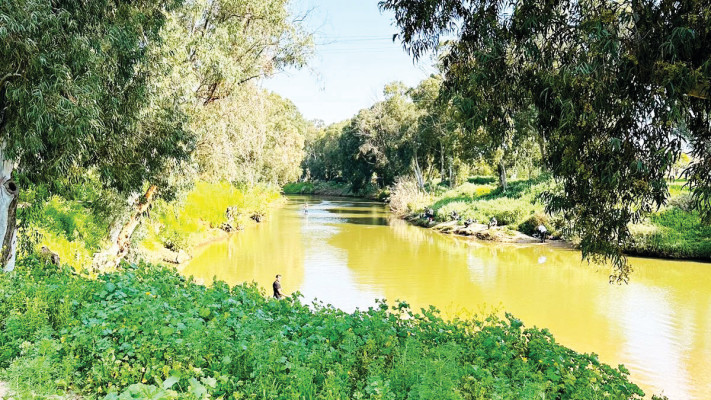
At the end of a long gray street in Tel Aviv, full of infrastructure works and a light rail, which goes by the name of Ibn Gvirol, a contrasting world suddenly emerges. Crossing one passage towards the Yarakon Park, the air becomes fresh, the chirping of the birds sounds like a chorus, ducks walk among runners on the path, couples hold hands, children ride bicycles, fishermen sit on the edge of the stream and boats wander in it.
It's hard to believe that all this is happening in the heart of Tel Aviv, but Yarkon Park is a great gift of nature to the urbanites among us. In the months of the war I rediscovered it, it became a regular site in the early morning hours when I started running all the sights I saw and the testimonies I heard. And he, a relaxed psychologist, accepted me with understanding and without judgment.
About two kilometers into the running track, right on the border between Tel Aviv and Ramat Gan, there is a new garden, called "The Garden of Experiences and Senses", a wonderful garden for all the parents among us. But I always slow down by it, in light of the view opposite.
At this exact point, there is one frame that also seems to be taken from another reality: the Yarkon stream curves, in the distance only a green horizon is visible and you can go down it from the paved path to the dirt path and feel that we have escaped far enough to gather strength further. So if you also need an easy escape this Passover, there is no need to go to the airport, nor to stand in possible lines at the entrance to the national parks. Come meet me in my special corner.
Beautiful there, and free
The Generous Garden // Meir Uziel
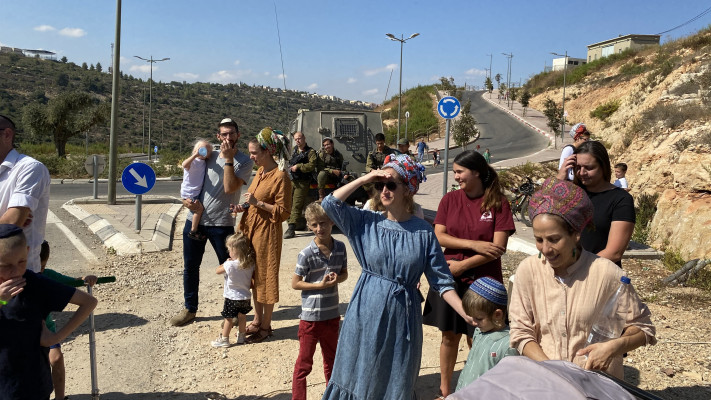
In my eyes, the most beautiful place in Israel is my little garden at home. I do not say this as a person who claims: what is mine is the most beautiful. No. This is a truly wonderful garden in its beauty. I walk there every day. I once read about an ancient Chinese poet who wrote poems all his life only about his small garden. Poems with lines that describe the chrysanthemums that bloom near the western fence.
And lines that describe the butterfly that hovers near the bamboo on the north side. I was fascinated. I said to myself: this is how you should live and this is how you should create. It was written in a book on the history of Chinese art, and I could not find the book or the poet's name again. If any of our readers know – I would love to know.
However, let's not avoid it. I was asked to write about a place in Israel. I no longer travel extensively in the country. I've already been to most of them, starting with the first annual trip I made to the Mikvah Israel in the third grade, where I saw as a child the wonderful ficus tree, with many trunks, to more distant trips, although it is difficult to go far in Israel. You cannot eat two meals on any trip to the end of the country, in any direction.

The place we travel to the most is the Generous Garden. recommended. There is a huge and well-kept garden next to the Jacob's memorial, which also contains the grave cave of Baron Rothschild. Beautiful there. Admission is always free. This, and the Baha'i gardens are examples of the level of cultivation that should be reached in this small country of ours.
I come to a conclusion. From time to time, in order to expand my soul, I travel to the beautiful settlements in Judea and Samaria. It doesn't matter which one. I so love to see this beauty. Sometimes I just go to Ariel, make a trip and return to Tel Aviv, half an hour each way.
From time to time I get to tour other places and other settlements. Not enough. Recently I was in a settlement called Kerem Reim, near Neria. There is nothing I like to see more than new houses in the Land of Israel. took a walk Spectacular view, also a spectacular human view. Everything is beautiful. How beautiful.
A surprise every visit
Sydney Ali Beach // Lilac Sigan
The place I find myself returning to every week is Sydney Ali Beach in Herzliya. Summer, winter, rain, scorching sun and missile threats do not stop us – me and two girlfriends – from our regular walking route along the beach, and the sea, it turns out, is really not the same sea. With every step he changes his face – sometimes blue and gold and smiling, sometimes clear and silver, and sometimes stormy with rage and threatening to close in on us.
At every step we are also a little different. Upset, relaxed, agreeing, arguing, laughing, panting up the steep side of Sydney Ali, breathing in for a moment the unique view from the top of the hill towards the sea dotted with white boats, then going back down to the shore and continuing on.
Sometimes the sand is soft and warm, and the stretch of beach along it is spacious and generous. Sometimes it is cold and swampy, lined with cracking shells and creaking stones, and sometimes it is narrow and ascetic, requiring sharp reflexes so that the gym shoes don't drown in the salt water.
A surprise awaits with every visit – jumping over huge and transparent jellyfish that have been ejected from the water, wading through small streams that have formed in the last rain, training sessions of enthusiastic recruits, long-haired sap surfers, or intoxicating silence when the Kurkar cliffs tower beside us and warn of an avalanche that does not actually happen.
The sadness, worries and frustrations always somehow disappear between the waves. The conversation flows even when the wind whistles and hits us in the face, making it difficult for us to hear the musings about relationships, mothers, design, work, politics and anti-Semitism. We march with determination while bringing down and bringing up governments, scolding the world for its unfairness, and comforting our friends with the fact that we burned some calories.
Walk peacefully – and keep quiet
The Prairie // Talia Levin
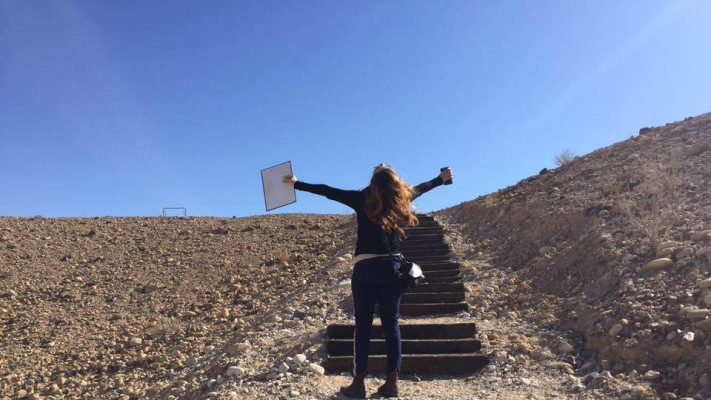
I fell in love with the magic of the prairie as a child. When we would pass there once a year on the annual family trip to Eilat, I would look out the car window and wonder who lived there in the middle of nowhere, behind the lonely sunny signs pointing with an arrow to the location of some settlement not visible from the road.
A few years ago, I decided to walk the Israel Trail, not in a sequence but in individual sections and not tiring on my feet. The prairie has an extremely short season, winter on days when there are no floods and spring. Then it starts to get too hot there. I discovered one of the most beautiful pieces of the desert oasis in the Arava – the settlement Tzukim, after walking section 46 of the Israel Trail. The starting point in Sapir settlement and the ending point in the rocks, a long but straight route, and you don't have to be an athlete to complete it.
After a walk that seemed like walking on the moon, and a view and spaces of divine creation, I realized that Tzukim is a gem in itself and not just a stop. The second time he was the target. Three days of delusion and reprogramming of the mind. A small artists' village, a simple cafe, a bench on the edge of a cliff where I sat with a notebook and pen as before. And at night outside the simple log cabin we lit a fire and looked at the stars.
In the desert there is awe in front of powerful nature, which is mixed with excitement. It is not always possible to contain these strengths in real time, but they remain there in the heart, and I find myself drawn to them again and again.
You don't have to be charitable or close an expensive B&B to enjoy the Arava. You can also stop there on the way to or on the way from for coffee and lunch, take a walk in the only place in Israel that might be able to bring some peace. and shut up.
A postcard never goes away
Levinsky market // Nir Kipnis
If I had only one hour to spend in Tel Aviv, I would choose to spend it in Levinsky Market – a postcard from a disappearing world whose remains can still be found between Aliya Street and Herzl Street and between Jaffa Road and Frankel Street.
This market, once the entrance to the Thessaloniki neighborhood named after David Florentin, has always been a market for fine and delicate ingredients, even in those days they were called "delicacies".
You can start on the outskirts of the destination, at Abermento on De Piguto Street, continue through the Persian restaurants on Nachalat Binyamin Street to the spice shops at the intersection with Levinsky Street, turn right to Haim Raphael's famous delicatessen, where his son, Tsadik Raphael is still serving customers, or turn left To return some calories in the form of borax to the body. The main thing is that you don't forget to take a look at the Aaroniko, which overlooks the age of 90 from above and still releases fish from tias or palmades by the hand of a master.
If you are in a hurry due to the long line in front of the entrance to Chaim Raphael, you are invited to go to Yom Tov across the street and if you feel like sipping a beer, Itzik the son and Lior the grandson will be waiting for you by the taps at Mati Mekelal, on the corner of Matlon and Zebulon streets.
Precisely in the last few years, when the market flourished as a culinary center in the "Master Chef" era, there is some sadness over its veterans: the Thessaloniki bakery has already closed and instead of spice shops new ventures are springing up. Is the world renewing itself or disappearing?
My recommendation: go to yourself one morning (preferably not on Friday, when the market is crowded), stroll through the small streets, treat yourself to a salami, a cheese wedge or a "shnit" of beer – and decide for yourself.
Eucalyptus Grove,
The bridge, the kayak
The Southern Jordan Estuary // Yossi Yosef
If you are looking for a compact, pastoral route with cultural value – you have come to the right place. In a fairly small radius you can experience the magic of the southern Jordan estuary. The access road to Kibbutz Kinneret separates two sites, one historical and of cultural importance and the other a special complex for Indian canoeing.
Driving south on Highway 90, turn to Kibbutz Kinneret, about 100 meters after, on the right side lies the mythical eucalyptus grove from a poem by Naomi Shemer, where you can walk among the eucalyptus trees and look for the elusive salty smell on the water. The route is short and there are the remains of the motor house that was used at the beginning of the last century as a compound for pumping water from the Jordan for the local pioneers.
Further down the road you can walk along the ancient Sea of Galilee which consists of a group of ponds and pastoral trees that provide a perfect setting for a short picnic. From there you can move east and reach the first date plantation ever planted in Israel and dedicated to the commemoration of Rachel the poet. It should be noted that the place is controlled and there are detailed explanations on each site.
After moving your body and sweating a bit, you can return to the access road, cross it and reach the "Rob Roy" complex, where a cool landing will await you that offers a unique Indian experience with diverse activities such as building rafts, observation games, Indian make-up, night kayaking, workshops Art, baking Indian pizzas and jeep tours in the views of the Jordan Valley. The sailing route is about three kilometers long, about an hour and a half, with comfort facilities and a buffet.
walk in the desert
Timna Park // Anat Moshe
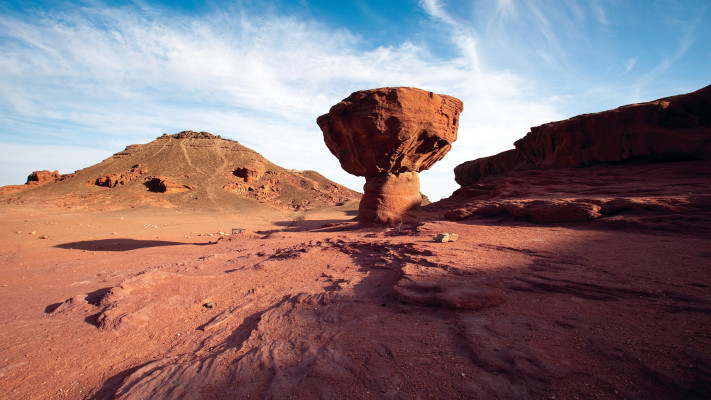
As a complete urbanite, there is something that deters me in the desert: the absolute silence, the stuttering cell phone reception, the lack of the possibility to pop in at nine in the evening to buy something that is missing. And the truth is that, in general, the changing of the colors of the landscape to brown on the way to Eilat always caused me some uneasiness, compared to the green of the north which always expands the heart and adds optimism. But then, somewhere during the Corona days when they explained to us that being away from humans is good, I discovered the beauty of the desert. The endless spaces, the horizon that a glance at does not reveal a single medical building, and this silence, which is not found anywhere else.
And if beauty is endless and quiet, then Timna Park offers all this and as a bonus the impressive landmarks that should not be missed – Solomon's Pillars and the famous mushroom. The trip in the large park is reminiscent of sights from abroad and allows you to get to know a spectacular view and various sites, which both adults and children can find interesting.
The park also has an accommodation complex, with various accommodation options – from tents of all kinds to caravans. And when the evening falls and the blazing sun is replaced by the moon, which, in the absence of the city lights, lights up the night alone, or then, in the absolute darkness and silence, one can truly detach from everything.
When you want to get your breath back
Nahal Birdi and the mill of the monks // Mittal Sharabi
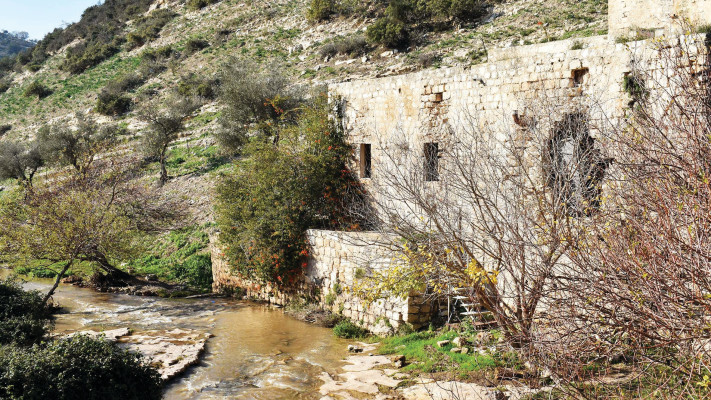
As someone who has been involved in tourism for many years, there isn't a Thursday that I don't receive messages from friends and family asking for a recommendation for a Shabbat trip. Of course, there are those who are already used to walking and enter my definition of good walkers, but more often than not, referrals are from friends with small children who are looking for a short walk on a route where you can see some water and not too far.
For those casual travelers, I always recommend a trip to Nahal Tzipori – which is one of the magical gems in the country and a place I always return to when I want to catch my breath.
The length of Nahal Tzipori is 32 kilometers, and it is one of the tributaries of the Kishon. The stream actually begins to flow in the mountains of Nazareth and goes down to the Zebulon Valley. And while the stream itself is an attraction, near it you can always see seasonal blooms, fruit trees and the famous monks' mill. The route along the stream is easy, so it is very suitable even if you have small children. In any case, the route is round trip on the same road.
There are many entrances to the stream, each offering its own surprises, but one of the most popular with families starts as mentioned at the monks' mill. The mill, which stands in the heart of all the green, was formerly used as a flour mill and was even a place of origin for the members of the Carmelite monastery. Beside it there are many areas where you can stop for a picnic or just enjoy the pleasant sun.
After a light meal, you start walking along the well-maintained path to Ein Yavka – otherwise known as the horse spring, and the only place where you can take a dip, since you are not allowed to enter the stream. If you don't want to walk about two kilometers to the spring, you can walk along the regulated promenade as much as you like and retrace your steps.
Still the top of the tracks
Jerusalem // Shari Makover-Blikov
The map of Israel is exciting and inviting. It has an infinite wealth of ravine and mountain, furrows and springs, ancient desert and landscape. Even though the north is bewitched, the center is innovative and the south, well the south is still foggy and recovering, I'm on Jerusalem. Maybe because as a child she was our undisputed attraction, somewhere between Montefiore's carriage and the coughs we conquered in the bell garden.
What did we not do in the coveted capital? We jumped into the hidden spring in Ein Kerem in clothes and shoes, my eldest sister swam with the guitar, the middle one dropped the food into the water, mother got lost in the shade of the olive groves and my little brother drowned in the depths until we pulled him out, spitting and fluttering, and with raccoon stingrays in his pocket. What did we not find in Jerusalem? A mosaic in the right of Moses, a rare fox in the biblical zoo, crispy falafel and the aroma of yeast and cinnamon in the alleys of the market.
Even today, Jerusalem was and still is in my eyes the summit of the routes. At every turn, on every pavement, you can learn history and culture. In every corner, in every alley, you can find a representative of a thousand and one currents: Jewish and Arab, ultra-Orthodox and religious, extremist and moderate, Lithuanian and Hasidic. This one is in his coat and this one is in her cloak and all of them together are fascinating and exciting and tell the story of their Jerusalem. Even today Mahane Yehuda is the most mind-blowing market, colorful and vibrant anyway, the Kotel is exciting and in the Jewish Quarter every resident is a story and every Abedkan is a Messiah. And not only the ice cream has the taste of Jerusalem, the bread also has the aroma and texture of a capital city.
Of all the places, Jerusalem was and will be my choice for a short track day or a family week. Because it is a city of contrasts, without compromises, non-stop, unique, full of secrets and flavors, new corners and neighborhoods with character. She is sane as well as instinctive, warm and communal and sometimes disturbing and disturbs peace.
But the human movement that takes place in it at all hours of the day is warm and fascinating, steeped in academia and culture, melodious Talmud melody, integrity and innocence, humility and intellect. Jerusalem. Every scrap contains the remains of the temple. Every piece of glass – Cleopatra's diamond. And halwa and pistachio – and all of this is packed in the unique, mesmerizing atmosphere of copper and light.
